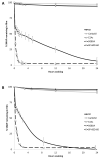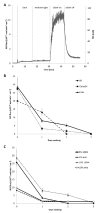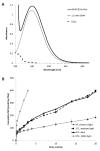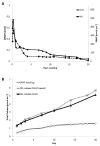Long-term nitric oxide release and elevated temperature stability with S-nitroso-N-acetylpenicillamine (SNAP)-doped Elast-eon E2As polymer
- PMID: 23777908
- PMCID: PMC3729938
- DOI: 10.1016/j.biomaterials.2013.05.063
Long-term nitric oxide release and elevated temperature stability with S-nitroso-N-acetylpenicillamine (SNAP)-doped Elast-eon E2As polymer
Abstract
Nitric oxide (NO) is known to be a potent inhibitor of platelet activation and adhesion. Healthy endothelial cells that line the inner walls of all blood vessels exhibit a NO flux of 0.5-4 × 10(-10) mol cm(-2) min(-1) that helps prevent thrombosis. Materials with a NO flux that is equivalent to this level are expected to exhibit similar anti-thrombotic properties. In this study, five biomedical grade polymers doped with S-nitroso-N-acetylpenicillamine (SNAP) were investigated for their potential to control the release of NO from the SNAP within the polymers, and further control the release of SNAP itself. SNAP in the Elast-eon E2As polymer creates an inexpensive, homogeneous coating that can locally deliver NO (via thermal and photochemical reactions) as well slowly release SNAP. Furthermore, SNAP is surprisingly stable in the E2As polymer, retaining 82% of the initial SNAP after 2 months storage at 37 °C. The E2As polymer containing SNAP was coated on the walls of extracorporeal circulation (ECC) circuits and exposed to 4 h blood flow in a rabbit model of extracorporeal circulation to examine the effects on platelet count, platelet function, clot area, and fibrinogen adsorption. After 4 h, platelet count was preserved at 100 ± 7% of baseline for the SNAP/E2As coated loops, compared to 60 ± 6% for E2As control circuits (n = 4). The SNAP/E2As coating also reduced the thrombus area when compared to the control (2.3 ± 0.6 and 3.4 ± 1.1 pixels/cm(2), respectively). The results suggest that the new SNAP/E2As coating has potential to improve the thromboresistance of intravascular catheters, grafts, and other blood-contacting medical devices, and exhibits excellent storage stability compared to previously reported NO release polymeric materials.
Copyright © 2013 Elsevier Ltd. All rights reserved.
Figures









Similar articles
-
Reduction in Thrombosis and Bacterial Adhesion with 7 Day Implantation of S-Nitroso-N-acetylpenicillamine (SNAP)-Doped Elast-eon E2As Catheters in Sheep.J Mater Chem B. 2015 Feb 28;3(8):1639-1645. doi: 10.1039/C4TB01839G. J Mater Chem B. 2015. PMID: 25685358 Free PMC article.
-
Origin of Long-Term Storage Stability and Nitric Oxide Release Behavior of CarboSil Polymer Doped with S-Nitroso-N-acetyl-D-penicillamine.ACS Appl Mater Interfaces. 2015 Oct 14;7(40):22218-27. doi: 10.1021/acsami.5b07501. Epub 2015 Oct 1. ACS Appl Mater Interfaces. 2015. PMID: 26393943 Free PMC article.
-
The hemocompatibility of a nitric oxide generating polymer that catalyzes S-nitrosothiol decomposition in an extracorporeal circulation model.Biomaterials. 2011 Sep;32(26):5957-69. doi: 10.1016/j.biomaterials.2011.03.036. Epub 2011 Jun 22. Biomaterials. 2011. PMID: 21696821 Free PMC article.
-
Polymers incorporating nitric oxide releasing/generating substances for improved biocompatibility of blood-contacting medical devices.Biomaterials. 2005 May;26(14):1685-93. doi: 10.1016/j.biomaterials.2004.06.006. Biomaterials. 2005. PMID: 15576142 Review.
-
Nitric oxide-releasing hydrophobic polymers: preparation, characterization, and potential biomedical applications.Free Radic Biol Med. 2004 Oct 1;37(7):926-36. doi: 10.1016/j.freeradbiomed.2004.06.019. Free Radic Biol Med. 2004. PMID: 15336308 Review.
Cited by
-
Recent Developments in Multifunctional Antimicrobial Surfaces and Applications toward Advanced Nitric Oxide-Based Biomaterials.ACS Mater Au. 2022 Sep 14;2(5):525-551. doi: 10.1021/acsmaterialsau.2c00040. Epub 2022 Aug 8. ACS Mater Au. 2022. PMID: 36124001 Free PMC article. Review.
-
Multifunctional S-Nitroso-N-acetylpenicillamine-Incorporated Medical-Grade Polymer with Selenium Interface for Biomedical Applications.ACS Appl Mater Interfaces. 2019 Sep 25;11(38):34652-34662. doi: 10.1021/acsami.9b10610. Epub 2019 Sep 10. ACS Appl Mater Interfaces. 2019. PMID: 31483604 Free PMC article.
-
S-Nitroso-N-acetyl-l-cysteine Ethyl Ester (SNACET) Catheter Lock Solution to Reduce Catheter-Associated Infections.ACS Appl Mater Interfaces. 2021 Jun 9;13(22):25813-25824. doi: 10.1021/acsami.1c06427. Epub 2021 May 24. ACS Appl Mater Interfaces. 2021. PMID: 34029456 Free PMC article.
-
Catalytic effect of transition metal-doped medical grade polymer on S-nitrosothiol decomposition and its biological response.Mater Adv. 2023 Jul 10;4(15):3197-3206. doi: 10.1039/d3ma00191a. eCollection 2023 Jul 31. Mater Adv. 2023. PMID: 38013687 Free PMC article.
-
Feedback-controlled photolytic gas phase nitric oxide delivery from S-nitrosothiol-doped silicone rubber films.J Control Release. 2020 Feb;318:264-269. doi: 10.1016/j.jconrel.2019.11.030. Epub 2019 Nov 25. J Control Release. 2020. PMID: 31778741 Free PMC article.
References
-
- Luo J-d, Chen AF. Nitric oxide: a newly discovered function on wound healing. Acta Pharmacol Sin. 2005;26:259–64. - PubMed
-
- Wallis JP. Nitric oxide and blood: a review. Transfus Med. 2005;15:1–11. - PubMed
-
- Williams DLH. A chemist's view of the nitric oxide story. Org Biomol Chem. 2003;1:441–9. - PubMed
-
- Baek SH, Hrabie JA, Keefer LK, Hou DM, Fineberg N, Rhoades R, et al. Augmentation of intrapericardial nitric oxide level by a prolonged-release nitric oxide donor reduces luminal narrowing after porcine coronary angioplasty. Circulation. 2002;105:2779–84. - PubMed
Publication types
MeSH terms
Substances
Grants and funding
LinkOut - more resources
Full Text Sources
Other Literature Sources
Miscellaneous

